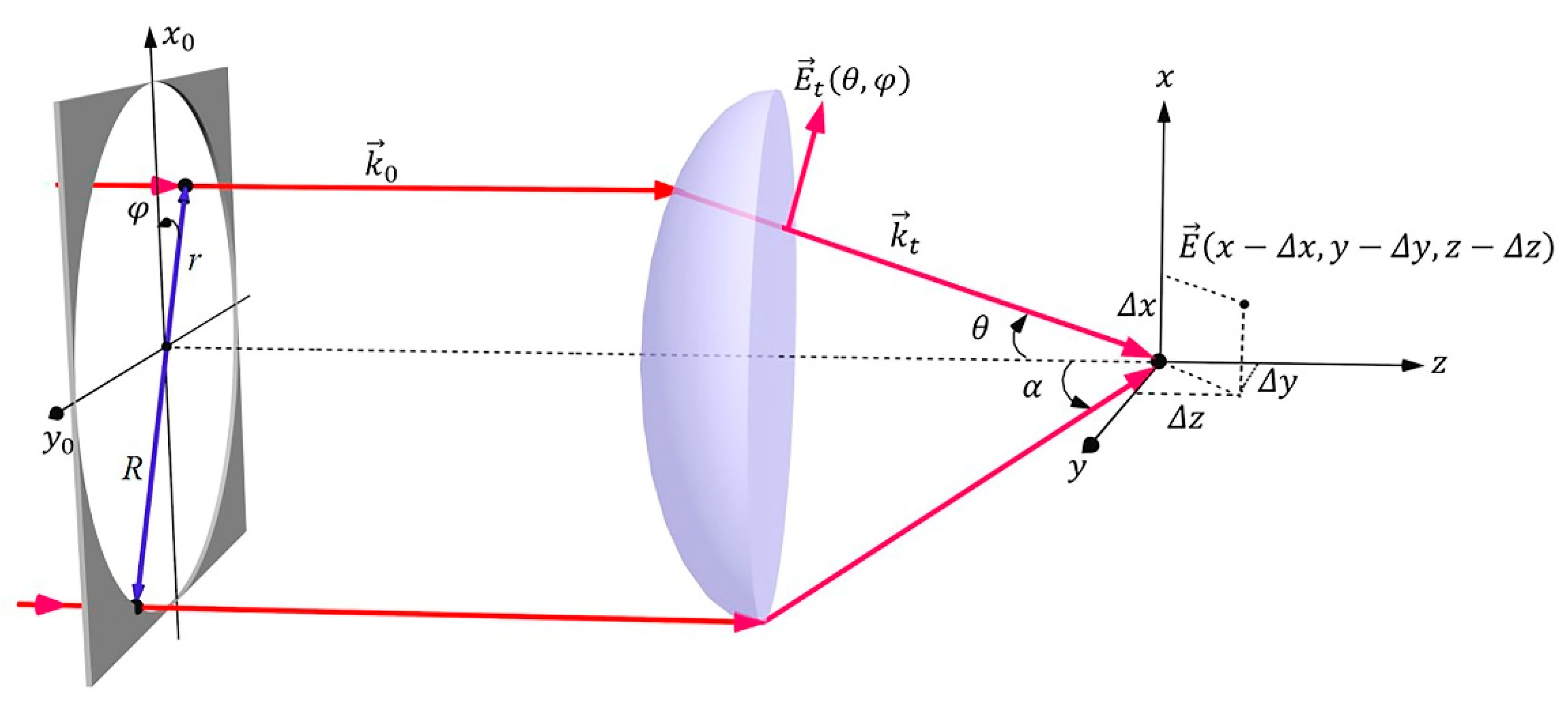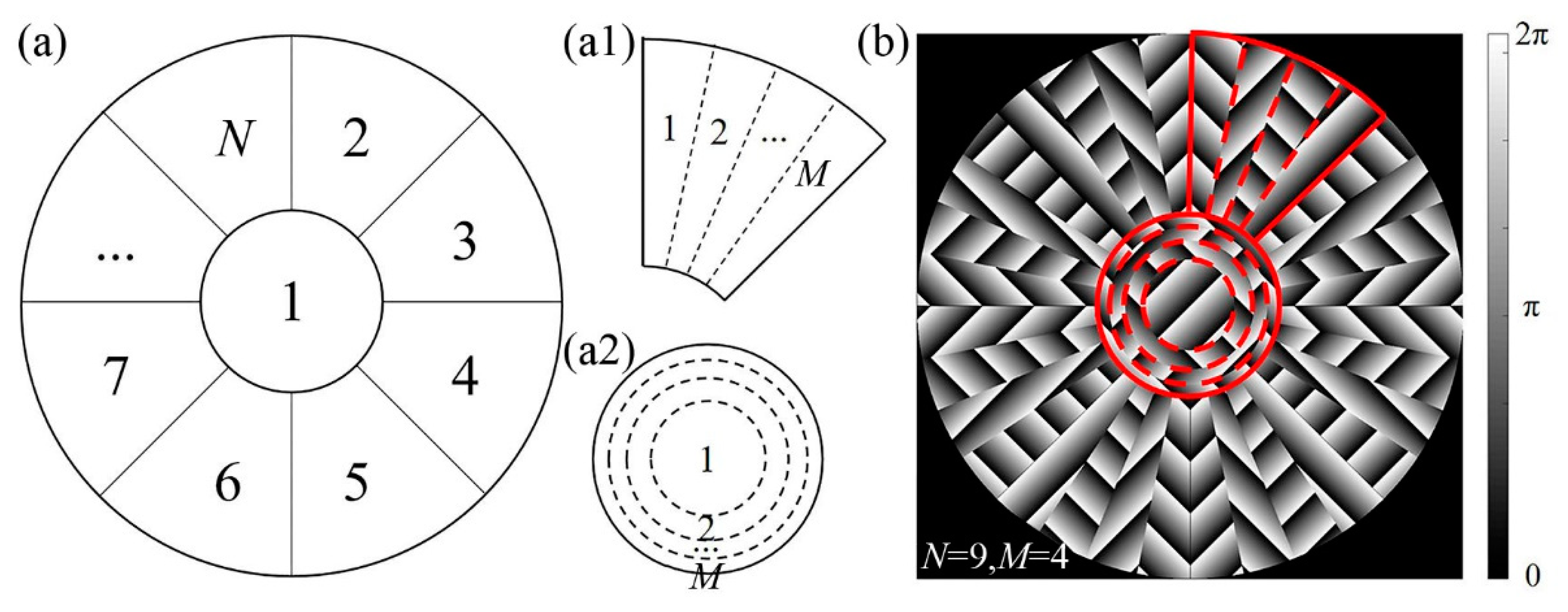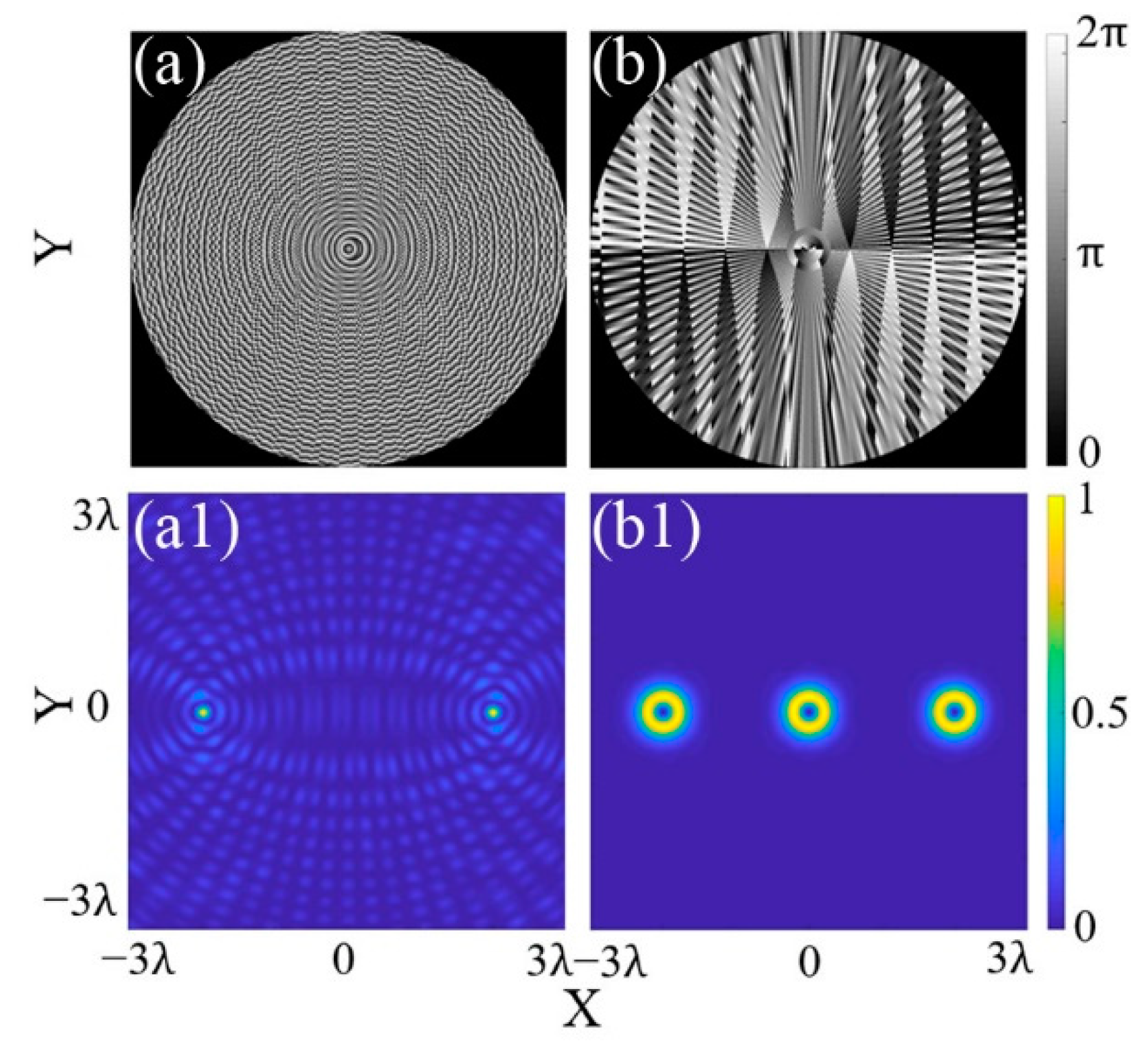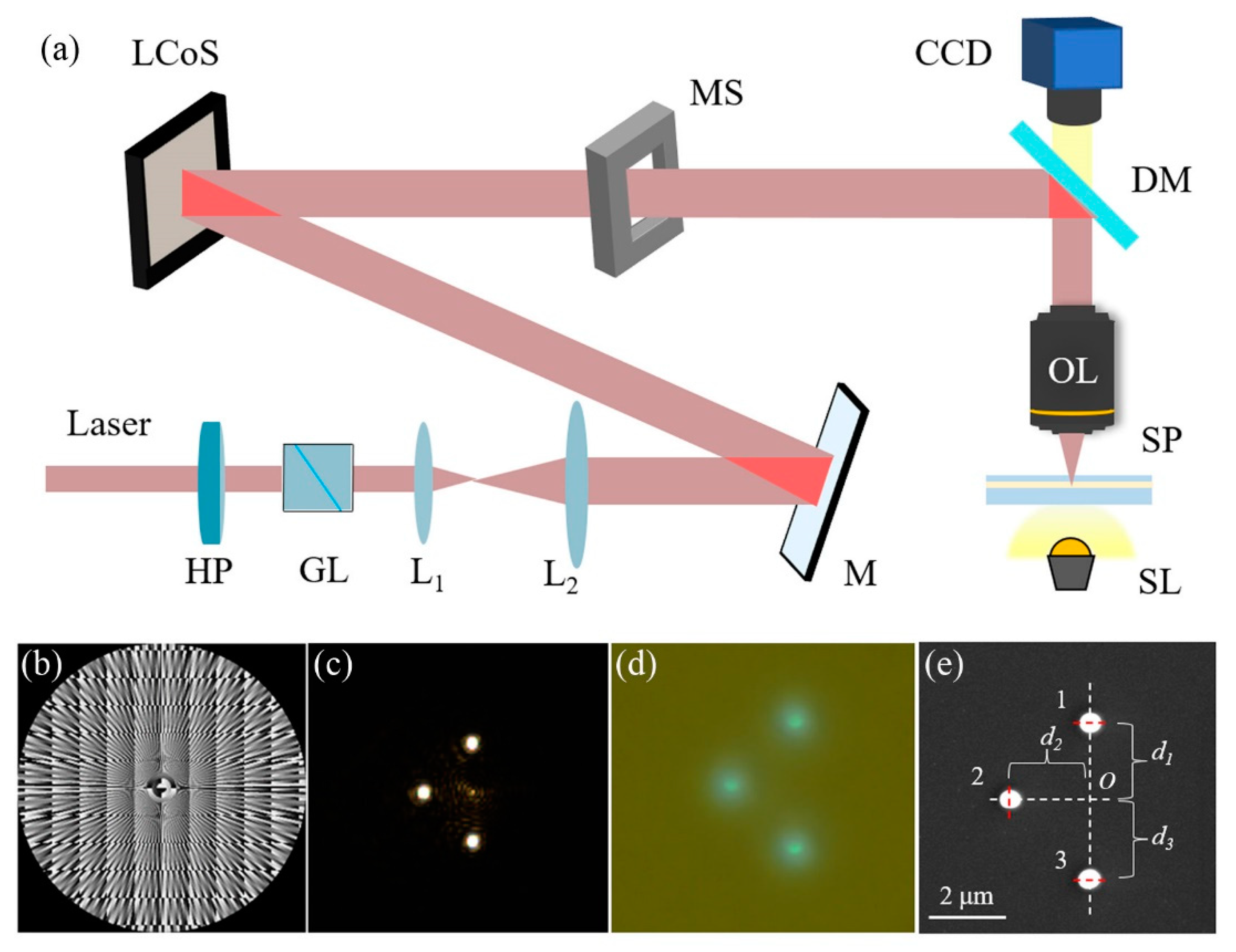Generation and Modulation of Controllable Multi-Focus Array Based on Phase Segmentation
Abstract
1. Introduction
2. Principles and Methods
2.1. The Principle of Focal Spot Positioning
2.2. The Principle of Phase Segmenting
3. Results and Discussion
3.1. Numerical Simulation
3.2. Analysis and Discussion
3.3. Experimental Study
4. Conclusions
Author Contributions
Funding
Data Availability Statement
Conflicts of Interest
References
- Zhao, L.; Huang, L.; Huang, J.; Xu, K.; Wang, M.; Xu, S.; Wang, X. Far-field parallel direct writing of sub-diffraction-limit metallic nanowires by spatially modulated femtosecond vector beam. Adv. Mater. Technol. 2022, 7, 2200125. [Google Scholar] [CrossRef]
- Xu, B.; Du, Q.; Li, W. High efficiency integration of three-dimensional functional microdevices inside a microfluidic chip by using femtosecond laser multifoci parallel microfabrication. Sci. Rep. 2016, 6, 19986. [Google Scholar] [CrossRef] [PubMed]
- Mahecic, D.; Gambarotto, D.; Douglass, M. Homogeneous multifocal excitation for high-throughput super-resolution imaging. Nat. Methods 2020, 17, 726–733. [Google Scholar] [CrossRef] [PubMed]
- Surag, S.; Sunil, V.; Chen, W.; Andrew, Y.; Yuan, L. Multifocal confocal microscopy using a volume holographic lenslet array illuminator. Opt. Express 2022, 30, 14910–14923. [Google Scholar] [CrossRef]
- Sun, F.Y.; Chen, M.; Liang, Y.; Song, H.L.; Wang, T.Y.; Liu, Z.K.; Sun, M.Y.; Zhu, L.W. Multifocal array optical tweezers based on non-orthogonal binary phase plates. Acta Opt. Sin. 2019, 39, 186–194. [Google Scholar] [CrossRef]
- Ma, Y.; Rui, G.; Gu, B.; Cui, Y. Trapping and manipulation of nanoparticles using multifocal optical vortex metalens. Sci. Rep. 2017, 7, 14611. [Google Scholar] [CrossRef] [PubMed]
- Dong, C.K.; Hermerschmidt, A.; Dyachenko, P.; Scharf, T. Inverse design and demonstration of high-performance wide-angle diffractive optical elements. Opt. Express 2020, 28, 22321–22333. [Google Scholar] [CrossRef]
- Chen, Z.; Zbek, A.; Rebling, J.; Zhou, Q.; Razansky, D. Multifocal structured illumination optoacoustic microscopy. Light Sci. Appl. 2020, 9, 152. [Google Scholar] [CrossRef]
- Bao, Y.; Jiang, Q.; Kang, Y.; Zhu, X.; Fang, Z. Enhanced optical performance of multifocal metalens with conic shapes. Light Sci. Appl. 2017, 6, 17071–17078. [Google Scholar] [CrossRef] [PubMed]
- Lee, J.H.; Chang, S.; Min, S.K.; Kim, Y.J.; Song, Y.M. High-Identical numerical aperture multifocal microlens array through single-step multi-sized hole patterning photolithography. Micromachines 2020, 11, 1068. [Google Scholar] [CrossRef]
- Jeong, K.H.; Bae, S.I.; Kim, K.S.; Yang, S.P.; Jang, K.W. Multifocal microlens arrays using multilayer photolithography. Opt. Express 2020, 28, 9082–9088. [Google Scholar] [CrossRef]
- Zhang, T.; Hernandez, O.; Chrapkiewicz, R.; Shai, A.; Schnitzer, M.J. Kilohertz two-photon brain imaging in awake mice. Nat. Methods 2019, 16, 1119–1122. [Google Scholar] [CrossRef]
- Burrow, G.M.; Gaylord, T.K. Multi-Beam interference advances and applications: Nano-electronics photonic crystals, metamaterials, subwavelength structures, optical trapping, and biomedical structures. Micromachines 2011, 2, 221. [Google Scholar] [CrossRef]
- Fang, H.H.; Ding, R.; Lu, S.Y.; Wang, L.; Feng, J.; Chen, Q.D.; Sun, H.B. Direct laser interference ablating nanostructures on organic crystals. Opt. Lett. 2012, 37, 686–688. [Google Scholar] [CrossRef] [PubMed]
- Zhang, C.; Zhang, W.; Yu, B.; Lin, D.; Qu, J. Enhanced multifocal structured illumination microscopy with desired optical sectioning capability and lateral resolution improvement. Opt. Express 2020, 28, 37946–37957. [Google Scholar] [CrossRef] [PubMed]
- Yu, J.; Zhou, C.; Lu, Y.; Wu, J.; Zhu, L.; Jia, W. Square lattices of quasi-perfect optical vortices generated by two-dimensional encoding continuous-phase gratings. Opt. Lett. 2015, 40, 2513–2516. [Google Scholar] [CrossRef] [PubMed]
- Wen, J.; Feng, H.; Liu, S.; Zhang, D. Arbitrary continuous nano-marks generated by multifocal spot arrays for controllable laser printing. Laser Phys. 2017, 27, 6201–6207. [Google Scholar] [CrossRef]
- Zhu, L.; Yu, J.; Zhang, D.; Sun, M.; Chen, J. Multifocal spot array generated by fractional Talbot effect phase-only modulation. Opt. Express 2014, 22, 9798–9808. [Google Scholar] [CrossRef] [PubMed]
- Nogrette, F.; Labuhn, H.; Ravets, S.; Barredo, D.; Béguin, L.; Vernier, A.; Lahaye, T.; Browaeys, A. Single-atom trapping in holographic 2D arrays of microtraps with arbitrary geometries. Phys. Rev. X 2014, 4, 021034. [Google Scholar] [CrossRef]
- Shi, Z.Y.; Zhou, L.Q.; Zhang, L.C.; Shi, Q. Dynamic laser parallel machining based on multifocal array. Acta Opt. Sin. 2020, 40, 406–408. [Google Scholar] [CrossRef]
- Zhang, L.; Zhai, Z.S.; Lv, Q.H.; Chen, B.; Liu, D. Research on high-efficiency parallel micro-hole machining technology by femtosecond laser. J. Hubei Univ. Technol. 2018, 33, 18–21. [Google Scholar]
- Kim, D.; Keesling, A.; Omran, A.; Levine, H.; Englund, D.R. Large-Scale uniform optical focus array generation with a phase spatial light modulator. Opt. Lett. 2019, 44, 3178–3181. [Google Scholar] [CrossRef] [PubMed]
- Zhu, L.; Sun, M.; Zhang, D.; Yu, J.; Wen, J.; Chen, J. Visualization 1: Multifocal array with controllable polarization in each focal spot. Opt. Express 2015, 23, 24688–24698. [Google Scholar] [CrossRef] [PubMed]
- Mu, T.; Chen, Z.; Pacheco, S. Generation of a controllable multifocal array from a modulated azimuthally polarized beam. Opt. Lett. 2016, 41, 261–264. [Google Scholar] [CrossRef] [PubMed]
- Guan, J.; Liu, N.; Chen, C.; Huang, X.; Tan, J.; Lin, J.; Jin, P. Non-iterative dartboard phase filter for achieving multifocal arrays by cylindrical vector beams. Opt. Express 2018, 26, 24075–24088. [Google Scholar] [CrossRef] [PubMed]
- Zhu, Y.; Zhang, C.; Gong, Y.; Zhao, W.; Wang, K. Realization of flexible and parallel laser direct writing by multifocal spot modulation. Opt. Express 2021, 29, 8698–8709. [Google Scholar] [CrossRef] [PubMed]
- Jia, B.; Lin, H.; Gu, M. Dynamic generation of Debye diffraction-limited multifocal arrays for direct laser printing nanofabrication. Opt. Lett. 2011, 36, 406–408. [Google Scholar] [CrossRef]








Publisher’s Note: MDPI stays neutral with regard to jurisdictional claims in published maps and institutional affiliations. |
© 2022 by the authors. Licensee MDPI, Basel, Switzerland. This article is an open access article distributed under the terms and conditions of the Creative Commons Attribution (CC BY) license (https://creativecommons.org/licenses/by/4.0/).
Share and Cite
Liu, Z.; Hou, J.; Zhang, Y.; Wen, T.; Fan, L.; Zhang, C.; Wang, K.; Bai, J. Generation and Modulation of Controllable Multi-Focus Array Based on Phase Segmentation. Micromachines 2022, 13, 1677. https://doi.org/10.3390/mi13101677
Liu Z, Hou J, Zhang Y, Wen T, Fan L, Zhang C, Wang K, Bai J. Generation and Modulation of Controllable Multi-Focus Array Based on Phase Segmentation. Micromachines. 2022; 13(10):1677. https://doi.org/10.3390/mi13101677
Chicago/Turabian StyleLiu, Zihan, Jiaqing Hou, Yu Zhang, Tong Wen, Lianbin Fan, Chen Zhang, Kaige Wang, and Jintao Bai. 2022. "Generation and Modulation of Controllable Multi-Focus Array Based on Phase Segmentation" Micromachines 13, no. 10: 1677. https://doi.org/10.3390/mi13101677
APA StyleLiu, Z., Hou, J., Zhang, Y., Wen, T., Fan, L., Zhang, C., Wang, K., & Bai, J. (2022). Generation and Modulation of Controllable Multi-Focus Array Based on Phase Segmentation. Micromachines, 13(10), 1677. https://doi.org/10.3390/mi13101677





